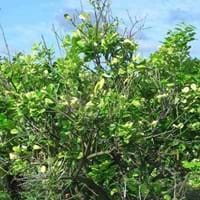Life Span
Perennial
Perennial
Origin
North America, United States, Northeastern United States, Mid-Atlantic United States, Southeastern United States, North-Central United States, South-Central United States, Texas
Southeastern Asia
Types
not available
Not Available
Habitat
Boggy areas, Fens, Fields, meadows, Swamps, Woodlands
Deep, gardens, old gardens, Well Drained
USDA Hardiness Zone
4-9
9-11
Sunset Zone
1a, 1b, 2a, 2b, 3a, 3b, 4, 5, 6, 7
H1, H2, 8, 9, 12, 13, 14, 15, 16, 17, 18, 19, 20, 21, 22, 23, 24
Habit
Thicket/Colonizing
Oval or Rounded
Flower Color
Not Available
White
Flower Color Modifier
Not Available
Bicolor
Fruit Color
Red
Yellow, Green, Yellow green
Leaf Color in Spring
Not Available
Green
Leaf Color in Summer
Not Available
Green
Leaf Color in Fall
Not Available
Green
Leaf Color in Winter
Not Available
Light Green
Leaf Shape
Oblovate
Ovate
Plant Season
Spring, Fall, Winter
Spring, Summer, Fall
Sunlight
Full Sun, Partial Sun
Full Sun, Partial Sun
Type of Soil
Clay, Loam
Loam, Sand
The pH of Soil
Acidic, Neutral, Alkaline
Acidic, Neutral
Soil Drainage
Average
Well drained
Bloom Time
Late Spring
Spring, Late Spring, Early Summer, Summer, Late Summer, Early Fall
Tolerances
Not Available
Drought
Where to Plant?
Ground, Pot
Ground
How to Plant?
Divison, Seedlings
Seedlings
Plant Maintenance
Medium
Medium
Watering Requirements
Keep the ground moist but not water-logged
Average Water Needs, Water Deeply
In Summer
Lots of watering
Lots of watering
In Spring
Moderate
Moderate
In Winter
Average Water
Average Water
Soil pH
Acidic, Neutral, Alkaline
Acidic, Neutral
Soil Type
Clay, Loam
Loam, Sand
Soil Drainage Capacity
Average
Well drained
Sun Exposure
Full Sun, Partial Sun
Full Sun, Partial Sun
Pruning
Prune after flowering, Prune in early spring, Remove damaged leaves, Remove dead branches, Remove dead leaves
Prune for shortening long shoots, Remove damaged leaves, Remove dead branches, Remove dead leaves, Thinning
Fertilizers
All-Purpose Liquid Fertilizer, Compost, Fertilize every year, Mulch, Nitrogen
Apply N-P-K, can go long without fertilizers
Pests and Diseases
Aphids, Apple Maggot, Fall Webworm, Red blotch, Scale
Armored scales, Fomes root rot, Mites, Red blotch
Plant Tolerance
Not Available
Cold climate, Drought, Heat And Humidity
Flowers
Showy
Insignificant
Flower Petal Number
Not Available
Single
Fragrant Bark/Stem
No
Yes
Foliage Texture
Not Available
Medium
Foliage Sheen
Not Available
Glossy
Attracts
Birds
Birds, Butterflies
Allergy
Not Available
Not Available
Aesthetic Uses
Showy Purposes
Bonsai
Beauty Benefits
Not Available
Not Available
Environmental Uses
Air purification
Air purification
Medicinal Uses
Not Available
Blood purifier, Digestion problems, Digestive disorders
Part of Plant Used
Fruits
Fruits, Leaves
Other Uses
Used As Food, Used as Ornamental plant
Making Shampoo, Used as insect repellent
Used As Indoor Plant
No
No
Used As Outdoor Plant
Yes
Yes
Garden Design
Cutflower, Mixed Border, Screening, Wind Break
Container, Edible, Fruit / Fruit Tree, Hedges, Mixed Border
Botanical Name
ARONIA arbutifolia
CITRUS hystrix
Common Name
Red Chokeberry
Kaffir Lime, Makrut
In Hindi
लाल Chokeberry
काफ़िर लाइम
In German
Rote Apfelbeere
Kaffernlimette
In French
Red Chokeberry
combava
In Spanish
rojo Chokeberry
cafre
In Greek
κόκκινο Chokeberry
Καφρός Lime
In Portuguese
Red Chokeberry
Kaffir Lime
In Polish
Red aronii
kaffir wapno
In Latin
arbutifolia
Cafres Lime
Phylum
Magnoliophyta
Tracheophyta
Class
Magnoliopsida
Magnoliopsida
Clade
Angiosperms, Eudicots, Rosids
Angiosperms, Eudicots, Rosids
Tribe
Not Available
Not Available
Subfamily
Not Available
Not Available
Number of Species
Not Available
Not Available
Season and Care of Red Chokeberry and Kaffir Lime
Season and care of Red Chokeberry and Kaffir Lime is important to know. While considering everything about Red Chokeberry and Kaffir Lime Care, growing season is an essential factor. Red Chokeberry season is Spring, Fall and Winter and Kaffir Lime season is Spring, Fall and Winter. The type of soil for Red Chokeberry is Clay, Loam and for Kaffir Lime is Loam, Sand while the PH of soil for Red Chokeberry is Acidic, Neutral, Alkaline and for Kaffir Lime is Acidic, Neutral.
Red Chokeberry and Kaffir Lime Physical Information
Red Chokeberry and Kaffir Lime physical information is very important for comparison. Red Chokeberry height is 180.00 cm and width 12.70 cm whereas Kaffir Lime height is 180.00 cm and width 240.00 cm. The color specification of Red Chokeberry and Kaffir Lime are as follows:
Red Chokeberry flower color: Not Available
Red Chokeberry leaf color: Not Available
Kaffir Lime flower color: White
- Kaffir Lime leaf color: Green
Care of Red Chokeberry and Kaffir Lime
Care of Red Chokeberry and Kaffir Lime include pruning, fertilizers, watering etc. Red Chokeberry pruning is done Prune after flowering, Prune in early spring, Remove damaged leaves, Remove dead branches and Remove dead leaves and Kaffir Lime pruning is done Prune for shortening long shoots, Remove damaged leaves, Remove dead branches, Remove dead leaves and Thinning. In summer Red Chokeberry needs Lots of watering and in winter, it needs Average Water. Whereas, in summer Kaffir Lime needs Lots of watering and in winter, it needs Average Water.





